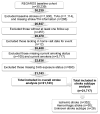Secondhand Smoke Exposure and Stroke: The Reasons for Geographic and Racial Differences in Stroke (REGARDS) Study
- PMID: 26117341
- PMCID: PMC4656115
- DOI: 10.1016/j.amepre.2015.04.014
Secondhand Smoke Exposure and Stroke: The Reasons for Geographic and Racial Differences in Stroke (REGARDS) Study
Abstract
Introduction: Stroke is a major public health concern worldwide given the associated morbidity and mortality. Smoking is a risk factor for stroke, but the relationship between secondhand smoke (SHS) exposure and stroke has been inconsistent to date. The aim of the current study was to examine the association of SHS exposure and risk of stroke and its subtypes (ischemic and hemorrhagic stroke) among nonsmokers.
Methods: Demographic and clinical characteristics were compared by SHS exposure status for African American and white nonsmokers aged ≥45 years in the Reasons for Geographic and Racial Differences in Stroke (REGARDS) study in 2014. Hazard ratios (HRs) and corresponding 95% CIs were calculated by Cox proportional hazards models to assess the relationship between SHS exposure and stroke risk.
Results: Of the 21,743 participants (38% African American, 45% male), SHS exposure in the past year was reported by 23%. Compared with those without SHS exposure, exposed participants were more likely to be female, white, younger, and reside with a smoker (all p<0.001). A total of 428 incident strokes were observed from April 2003 to March 2012 during a mean follow-up of 5.6 years. The risk of overall stroke was increased 30% among those with SHS exposure after adjustment for other stroke risk factors (95% CI=2%, 67%). This relationship appeared to be driven by ischemic strokes.
Conclusions: SHS exposure is independently associated with an increased risk of stroke. Future studies are needed to confirm these findings and examine the role of long-term effects of SHS exposure on stroke outcomes.
Copyright © 2015 American Journal of Preventive Medicine. Published by Elsevier Inc. All rights reserved.
References
-
- Lozano R, Naghavi M, Foreman K, et al. Global and regional mortality from 235 causes of death for 20 age groups in 1990 and 2010: a systematic analysis for the Global Burden of Disease Study 2010. Lancet. 2013;380(9859):2095–2128. http://dx.doi.org/10.1016/S0140-6736(12)61728-0. - DOI - PMC - PubMed
-
- Go AS, Mozaffarian D, Roger VL, et al. Heart disease and stroke statistics--2014 update: a report from the American Heart Association. Circulation. 2014;129(3):e28–e292. http://dx.doi.org/10.1161/01.cir.0000441139.02102.80. - DOI - PMC - PubMed
-
- Murphy SL, Xu J, Kochanek KD. Deaths: final data for 2010. Natl Vital Stat Rep. 2013;61(4):1–117. - PubMed
-
- U. S. Burden of Disease Collaborators. The state of U.S. health, 1990–2010: burden of diseases, injuries, and risk factors. JAMA. 2013;310(6):591–608. http://dx.doi.org/10.1001/jama.2013.13805. - DOI - PMC - PubMed
-
- Kleindorfer D, Broderick J, Khoury J, et al. The unchanging incidence and case-fatality of stroke in the 1990s: a population-based study. Stroke. 2006;37(10):2473–2478. http://dx.doi.org/10.1161/01.STR.0000242766.65550.92. - DOI - PubMed
Publication types
MeSH terms
Substances
Grants and funding
LinkOut - more resources
Full Text Sources
Other Literature Sources
Medical
Miscellaneous


